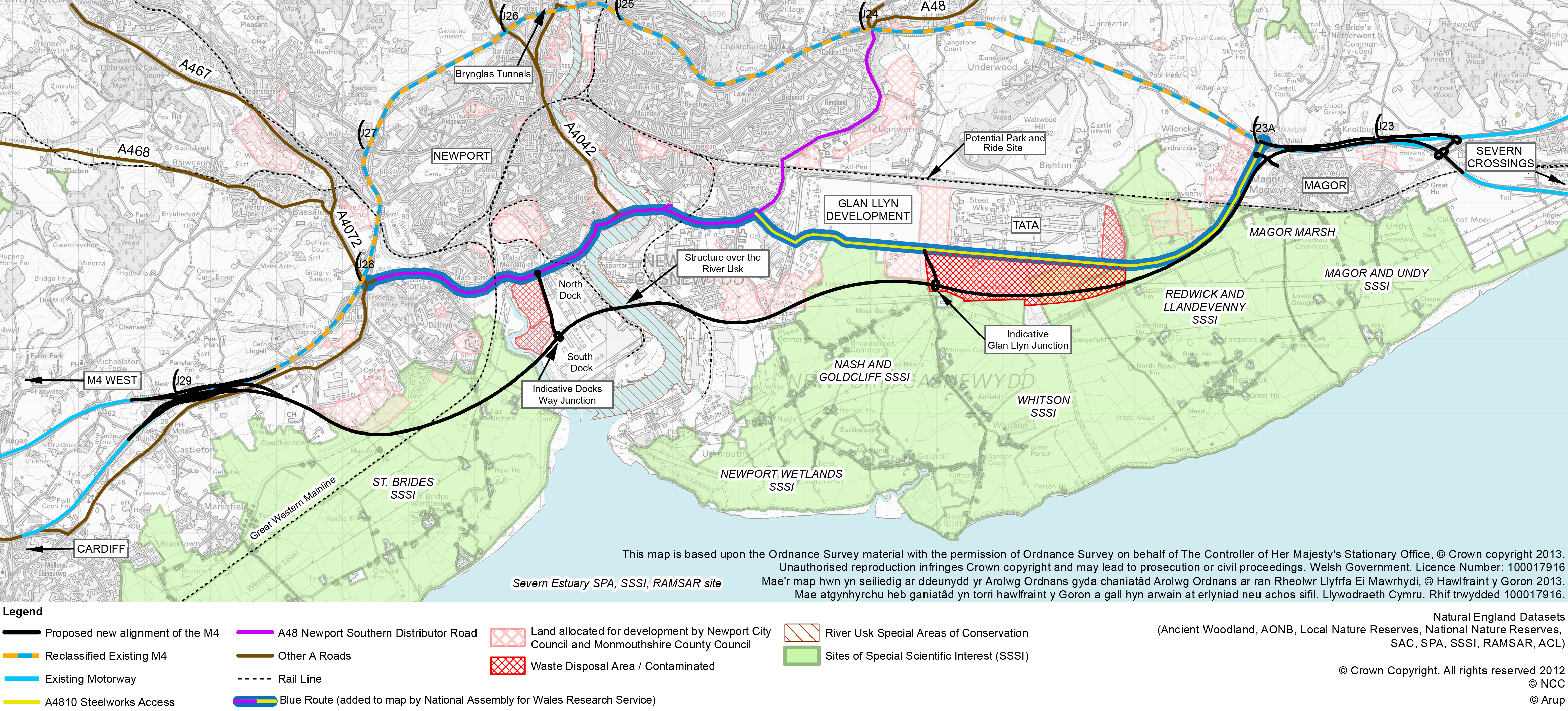Article by Andrew Minnis, National Assembly for Wales Research Service
This article is taken from ‘Key issues for the Fifth Assembly’, published on 12 May 2016.
Congestion on the M4 around Newport has a major impact on south Wales, particularly on the economy. Are the financial and environmental costs of the proposed relief road justified?
The new Welsh Government will have to take key decisions early in the Fifth Assembly on what would be the Welsh Government’s biggest infrastructure project to date – the M4 relief road.  .
.
The plan
Proposals to increase capacity on the M4 around Newport have been discussed since the early 1990s when the UK Government identified a preferred route, broadly similar to current proposals. Although deemed unaffordable in 2009, the 2013 agreement between the Welsh and UK Governments on borrowing powers revived the project. In 2014, the Welsh Government published M4 Corridor Around Newport - The Plan setting out the preferred route for a three-lane motorway south of Newport between Magor and Castleton. The document listed four key factors underpinning the plan:
- capacity: J23A to J29 of the current M4 will see traffic flows above 100% of capacity during weekday peak periods by 2037;
- resilience: there is a need to improve the network’s ability to cope with collisions and incidents;
- safety issues: the current M4 has design limitations, while growing congestion increases incidents and collisions; and
- sustainable development: congestion is a barrier to economic growth, while poor air quality and noise pollution increasingly affect local communities.
The debate
The need to address M4 congestion is widely accepted, but the proposed solution is hotly contested. CBI Wales published a plan for prosperity in November 2015, arguing for significant transport infrastructure investment. The M4 relief road is central to this plan. CBI Wales claims that the relief road is essential to unblock this important infrastructure link, and so will increase prosperity and employment in south and west Wales. It also says that cancelling the project would have long-term consequences for the Welsh Government’s reputation within the business community. The South Wales Chamber of Commerce has also argued in its campaign for Welsh business 2015-2020 that the road, along with other key transport investments such as the south-east Wales Metro and electrification of the north Wales main railway line, is necessary for investor confidence. In 2013, 34% of its members said the current M4 had a negative impact on their business, with the Welsh Government’s preferred route supported by 76% of members across south Wales. The business community is not universally in favour. In its response to the draft plan consultation, FSB Wales questioned the accuracy of the forecasting model used to predict traffic growth. It raised doubts about the affordability of the project in the light of wider transport investment commitments, and argued that the impact of the Metro and sustainable travel policy on reducing congestion have not been considered properly. FSB Wales also claimed that the scheme’s environmental impact had not been assessed effectively at that stage. The strongest opponents are environmental organisations, a number of whom formed the Campaign Against the Levels Motorway (CALM) alliance. They are primarily against the route passing through the Gwent Levels, which includes Sites of Special Scientific Interest and other heavily protected areas. CALM argues that the road threatens one of the UK’s largest surviving ancient grazing marshes and the water systems that support unique wildlife. In addition to direct loss of habitat, it believes the road would create a barrier to wildlife and water movement, while pollution run off would adversely affect water quality. CALM is also concerned about the plan’s potential carbon emission impact. Along with FSB Wales and others, CALM has supported the Blue Route proposed by Professor Stuart Cole.
The Blue Route
The Blue Route (PDF 724 KB) would would use a combination of the A48 Newport Southern Distributor Road and the former Steelworks Road on the eastern side of Newport to create a new dual carriageway. Supporters argue that this would be both cheaper and quicker to build than the relief road.
The previous Welsh Government published an appraisal of alternatives considered during the consultation process (PDF 2.39MB) which suggested that the blue route would not achieve the scheme objectives, and would itself require significant investment with insufficient benefit.
The future
In March 2016 the Welsh Government published the scheme’s environmental statement, setting out actions to mitigate negative environmental effects. How far this addresses environmental concerns is not yet clear. The Welsh Government also published draft legislation paving the way for construction, along with a range of wider reports. The First Minister told the Fourth Assembly in May 2015 that the scheme would cost ‘well below’ £1 billion. While the estimated construction cost set out in the new documents is £857 million, including £45m for environment and landscape works, the economic appraisal report estimates the total cost at £1.131 billion, excluding VAT and inflation. Based on responses to the environmental statement and draft orders, the new Welsh Government will need to decide whether to hold a public local enquiry, probably in autumn or winter 2017. Based on the enquiry report, the new Welsh Government would then have to decide whether to proceed. If it did, barring legal challenge, construction could begin in spring 2018, with opening planned for autumn 2021.
Key Sources
- CBI Wales, A plan for prosperity (2015)
- Federation of Small Business Cymru, M4 relief road consultation response (PDF 628KB) (2013)
- Institute for Welsh Affairs, The Blue Route (PDF 724KB) (2013)
- South Wales Chamber of Commerce, Campaign for Welsh Business 2015-2020 (PDF 1,522KB) (2014)
- Welsh Government, M4 Corridor Around Newport (website)
- Welsh Government, M4 relief road environmental information (website)
- Welsh Government, M4 draft orders (website)
- Welsh Government, M4 associated reporting (website)






